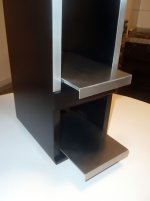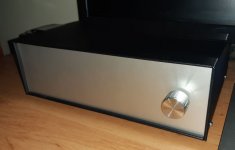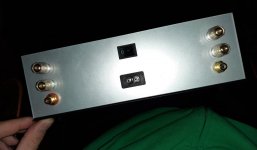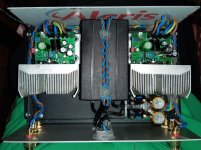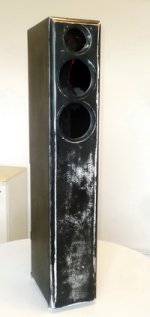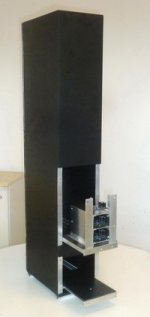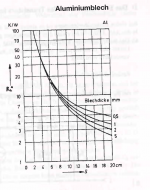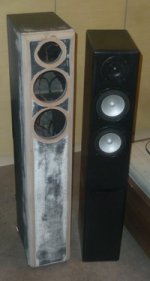Makes perfect sense.
So many people attenuate their signals heavily just to amplify it afterwards.
I have to plan my "gain structure" anyway as I´m using a minidsp and thus AD-DA-conversion which makes noise problems even more prominent.
I´m in the process of making a really small PSU-board (~80x55mm) with just 6 caps of max. 16mm in diameter if anybody in the EU is interested (couple cents + shipping) but that will probably be another 2 weeks or so.
So many people attenuate their signals heavily just to amplify it afterwards.
I have to plan my "gain structure" anyway as I´m using a minidsp and thus AD-DA-conversion which makes noise problems even more prominent.
I´m in the process of making a really small PSU-board (~80x55mm) with just 6 caps of max. 16mm in diameter if anybody in the EU is interested (couple cents + shipping) but that will probably be another 2 weeks or so.
Hey People,
this will be the Home for three O.S. LM3886. The Problem atm is the lack of a Router for the Chassis-Seatings (what is the right Word?) in the Frontplate.
The PSU will be placed in the lower Compartment, the Amps in the upper One. All Electronics will be mounted on Aluminium Plates which will be screwed on Drawer-Rails for easy Access. Both Compartments get thick 8mm Aluminium Backplates, of which the upper One will be cooling the Amps.
this will be the Home for three O.S. LM3886. The Problem atm is the lack of a Router for the Chassis-Seatings (what is the right Word?) in the Frontplate.
The PSU will be placed in the lower Compartment, the Amps in the upper One. All Electronics will be mounted on Aluminium Plates which will be screwed on Drawer-Rails for easy Access. Both Compartments get thick 8mm Aluminium Backplates, of which the upper One will be cooling the Amps.
Attachments
Hey Folks,
short Question: my first diy-Speakers were driven by three LM1875/Box. Now I'm building Mk.II of "MY BOX" with LM3886 instead of LM1875. The Boxes are 2.5-way and will have the "old" Chassis from the first Try (2x Gradient W 130 AL 8 + 1x Monacor DTM 104/8). Compared to the Midwoofers, how much Watts would the Tweeter 1" Softdome consume? Long Story short, I'd like to use a LM1875 for the Tweeter and two LM3886 for the Midwoofers. Will this fit? (PSU will be a Toroid 18-0-18V/ 300VA + a Bunch LCR 4700µF)
short Question: my first diy-Speakers were driven by three LM1875/Box. Now I'm building Mk.II of "MY BOX" with LM3886 instead of LM1875. The Boxes are 2.5-way and will have the "old" Chassis from the first Try (2x Gradient W 130 AL 8 + 1x Monacor DTM 104/8). Compared to the Midwoofers, how much Watts would the Tweeter 1" Softdome consume? Long Story short, I'd like to use a LM1875 for the Tweeter and two LM3886 for the Midwoofers. Will this fit? (PSU will be a Toroid 18-0-18V/ 300VA + a Bunch LCR 4700µF)
Hi
The watts what are "need" are depending of the efficiency of the speakers e.g. if the tweeter has a higher value 90db + the xover e.g. the resistor before the tweeter.
it is important that the gain of all amps are the same.
chris
The watts what are "need" are depending of the efficiency of the speakers e.g. if the tweeter has a higher value 90db + the xover e.g. the resistor before the tweeter.
it is important that the gain of all amps are the same.
chris
It fit before (powerwise) and it will in future.Will this fit?
The W130AL can take quite a bit of power but you don´t need a 75W for each.
The 50W or so of your LM3886 with 2x18VAC should be fine and that toroid for all amps is fine.
(I had a W160AL8, considered almost fullrange, and it was one hell of a nice woofer! Guess the W130AL is similar)
The obvious: test your new amps with a dummy load and check for proper function and DC-offset.
And if you don´t use a "safety" capacitor in series with the tweeters, don´t mix up woofer and tweeter cable ;-)
Why do you think that? I don´t see the point. I have different amps for woofer and fullrange; different gain as well.it is important that the gain of all amps are the same
I have to adjust the level because of different sensitivities anyway; that wouldn´t be any different with amps having the same gain.
Last edited:
The DC protect board is mostly coming from the discussions here and the detector is a simplified version from ESP protection project. The added led indicates when the protection triggers.
It works well in sims and I've used that detector before so I know it works well. This implementation is pretty bare with no mute at turn-on, turn-off but the lm3886 is well behaved under that respect. It's made to be powered from the positive power rail.
Have many people tested this protect board?
How do you think it would work with the Christmas Amp?
I designed my own DC protect pcb.
It uses a PIC microcontroller to sense DC.
I used mosfets to switch audio to speaker.
Its mains powered but uses a cheap tiny transformer.
Opto coupled between PIC and mosfets.

It uses a PIC microcontroller to sense DC.
I used mosfets to switch audio to speaker.
Its mains powered but uses a cheap tiny transformer.
Opto coupled between PIC and mosfets.

@ Chermann, I didn' wanted a Number, just the average Percentage, how much of 100% Psu-Power the Tweeter draws when playing together with two 5" Midwoofers.
Project "Shelter for the homeless ChipAmps" is getting darker. 😉
Project "Shelter for the homeless ChipAmps" is getting darker. 😉
Attachments
Hi
@ Chermann, I didn' wanted a Number, just the average Percentage, how much of 100% Psu-Power the Tweeter draws when playing together with two 5" Midwoofers.
nothing you should worry about...the tweeter need not more then 5% i guess
@ Chermann, I didn' wanted a Number, just the average Percentage, how much of 100% Psu-Power the Tweeter draws when playing together with two 5" Midwoofers.
nothing you should worry about...the tweeter need not more then 5% i guess
hello guys,
I have ordered some boards for this amp. I am planning to use the psu pcb by chipamp.com. Does anyone have a BOM for this power supply?
Thanks!
I have ordered some boards for this amp. I am planning to use the psu pcb by chipamp.com. Does anyone have a BOM for this power supply?
Thanks!
I can't recall now, I just sticked with the schematic markings.
The smps are 2x24V (in series) and the linear one is 2x21V.
The hottest temp after running 2 hours, as measured by a Caterpillar Flir cam, was around 45 deg. Celsius.
I decided it's worthy to put together a compact stereo and a 10K pot (conductive plastic) will be installed in the end. Hopefully, I' ll put some nice pictures one day
Here's my compact build using 2x24 SMPS in series with some extra filtering and 2x4700uF reservoirs. With the pot on input the amp performs good, I can't hear that hiss anymore. There is absolutely no noticeable noise at low levels. By now I've conected it only to a low sensytivity speakers and I'm happy with it.
Attachments
Last edited:
Hi Folks,
no Tools, no Room, no Brain, no Budget,
it goes on slowly ... .
Just small pics of Front & Back because of limited Bandwidth.
The Amps are about 20% done, more Parts will arrive in a few Days.
The Cover for the Amp Compartment will be 190 x 300 x 8mm Aluminium Plate and will also be cooling the Amps.
Many Thanks @ All who made this possible!
no Tools, no Room, no Brain, no Budget,
it goes on slowly ... .
Just small pics of Front & Back because of limited Bandwidth.
The Amps are about 20% done, more Parts will arrive in a few Days.
The Cover for the Amp Compartment will be 190 x 300 x 8mm Aluminium Plate and will also be cooling the Amps.
Many Thanks @ All who made this possible!
Attachments
Last edited:
Attached you will find a graph for the thermal resistance of aluminium sheets (upper right graph).The Cover for the Amp Compartment will be 190 x 300 x 8mm Aluminium Plate and will also be cooling the Amps.
x-axis is length&width of the aluminium square in [cm].
Rth on the y-axis.
"Blechdicke" is the thickness of the sheet in [mm].
When used in a horizontal orientation multiply Rth with factor 1.2.
That said I guess we don´t have to be that scientific about it and you´ll be more than alright if there is a path for the hot air.
Attachments
Hi Folks,
no Tools, no Room, no Brain, no Budget,
it goes on slowly ... .
Just small pics of Front & Back because of limited Bandwidth.
The Amps are about 20% done, more Parts will arrive in a few Days.
The Cover for the Amp Compartment will be 190 x 300 x 8mm Aluminium Plate and will also be cooling the Amps.
Many Thanks @ All who made this possible!
That's looking spectacular, keep it up!
Seems to late for an edit. I am thinking of add on DC-Servos for the LM3886 Amps. How much Current does a Servo OP-Amp draw? It's because I'm using a Fairchild RC4195 Voltage Regulator and I doubt if it delivers enough Current?
I would not use different amps either , it will not save any money at all but will require different supply voltages for one thing and limit the max impulse to the tweeters instead of assuring that the amp driving the tweeter NEVER clips!
Much more important is protecting the tweeter from any DC which is done best by a correctly sized capacitor because that has no reaction time as any electronic circuit would. all you have to do is choose the right type and capacitance depending on the cross-over frequency , not to introduce any phase shift at the tweeters lowest reproduced frequency , and a voltage rating of your rail voltage x 1,5 or more. That way you´ll never have DC on yout tweeter , even if the amp goes up in flames. I consider not torturing a tweeter with a clipping amp very important.
Much more important is protecting the tweeter from any DC which is done best by a correctly sized capacitor because that has no reaction time as any electronic circuit would. all you have to do is choose the right type and capacitance depending on the cross-over frequency , not to introduce any phase shift at the tweeters lowest reproduced frequency , and a voltage rating of your rail voltage x 1,5 or more. That way you´ll never have DC on yout tweeter , even if the amp goes up in flames. I consider not torturing a tweeter with a clipping amp very important.
"Much more important is protecting the tweeter from any DC which is done best by a correctly sized capacitor"
Which capacitor are you talking about? A highpass in line with the speaker? I am using a 6,6µF NP which means a first order HP @ 3000Hz as tweeter protection.
Which capacitor are you talking about? A highpass in line with the speaker? I am using a 6,6µF NP which means a first order HP @ 3000Hz as tweeter protection.
- Home
- Amplifiers
- Chip Amps
- An open source layout for LM3886?


